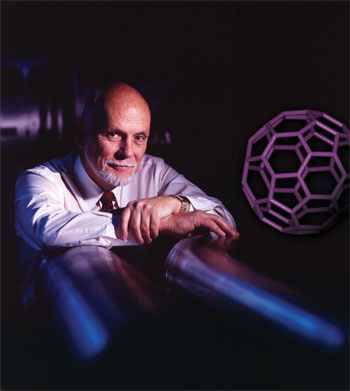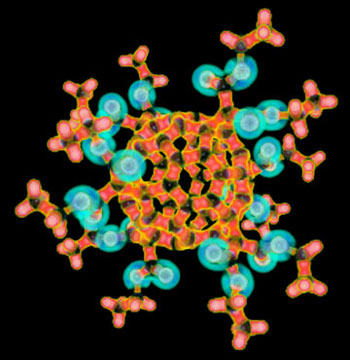 by Preston MacDougall November 05, 2005
There were no waterworks, but I definitely felt a lump in my throat when I was scrolling down the homepage of the New York Times last Saturday and saw "Richard E. Smalley, 62, Dies; Chemistry Nobel Winner."
Please, no! It can't be true. It shouldn't be true. But the past-tense recollections of James Heath, a Caltech chemistry professor, and one of Rick Smalley's best known students, left no room to doubt the tragic conclusion to the life of nanotechnology's guiding light. According to the spokesman from Rice University, in Houston, Professor Smalley died fighting leukemia, or blood cancer. Deep respect and admiration were evident in his former student's account of how Rick, bald and weakened from his chemotherapy, had simultaneously fought for Congressional passage of the National Nanotechnology Initiative in 2000. In Dr. Heath's estimation, "Rick was, more than anybody else, a Moses for the field. Without a Moses, there's no trip to the promised land." From my perspective, however, they had already arrived. The 1985 discovery, in Professor Smalley's lab, of a remarkably stable, and beautifully symmetric all-carbon molecule, which he named buckminsterfullerene, heralded a new age in materials chemistry. Going by mass, organic compounds are mostly composed of the element carbon. This is true for methane, DNA, and the infinite variety of possibilities in between. Previously, diamond and graphite were the only all-carbon forms of matter known. Blessed by their own unique chemical and physical properties, they each have had many important societal uses. In addition to their brilliant appearance, diamonds are quite impressive as functional materials. No natural or synthetic substance is harder than diamond, and its exceptional ability to conduct heat, but not electricity, often make diamonds an engineer's best friend. On the other hand, graphite, which is opaque and gray, is flaky. For this reason, it is useful in writing instruments. Its utilitarian abilities really shine, however, when you want to move large amounts of electricity (which generates a lot of heat). Graphite conducts electricity well, and has a higher melting point than any metal. Most metals corrode if unprotected and exposed to water. Graphite is fairly inert chemically, so it makes great electrodes. If you have used a vaporizer in a sick child's room, or forged a letter from Santa Claus using a pencil, then the poor man's form of carbon has been your friend. Nobody was looking for a third form of carbon when Rick Smalley assembled a plastic model of a sixty-atom molecule of pure carbon that perfectly resembled a soccer ball (12 pentagons, each surrounded by five hexagons), in his kitchen. This model explained the very large, and unexpected peak in the distribution of masses that he and his collaborators had observed in his unique conjunction of laser technology and mass spectrometry.
It stood out because most small fragments of carbon, whether they are nanoscale chunks of diamond, flakes of graphite, or some irregular shape, all have loose ends and are just as likely to have a few more, or a few less carbon atoms. However, because of the way carbon atoms bond to one another, six of them can form a very stable and flat structure. Graphite is this hexagonal pattern repeated as far as an imaginary nanoman could see, with similar terrain repeated layer after layer, above and below. The occasional absence of a carbon atom, resulting in a pentagon, causes a slight warping of the sheet. If there are the right numbers of such "defects", and they situate themselves just so - all atoms jostle all the time - then the edge of a 60-carbon sheet meets up, forming a ball. This is what happened in Rick Smalley's lab. We now know it happens in stardust also, which is what British chemistry professor Harold Kroto had initially visited Smalley's lab to simulate. Rick's plastic model reminded him of the geodesic domes designed by architect Buckminster Fuller, hence the name buckminsterfullerene. In the intervening years, chemists have lovingly referred to them as "buckyballs". They can now be made in large-scale quantities, although Rick always wanted more, cheaper. Change the conditions, and the sheets will roll up to form "buckytubes." For our nanoman, these tubes would be like graphitic tunnels that extend straight and far. It was these nanotubes that excited Rick more than anything. They could combine the strength of diamond with the current capacity of graphite. On top of that, chemists were quickly finding ways to chemically modify the surfaces of buckyballs and buckytubes, adding the full force of synthetic organic chemistry to the repertoire of these little marvels. Rick Smalley envisioned that society-changing technologies would result from the development of fullerene chemistry, and this may be the "promised land" referred to by his student. I don't doubt that these will come, but surely creating a new field of chemistry is as close to Nirvana as a chemist can get. My mother still regrets not seeing Elvis perform live. I treasure the pleasure of seeing Rick give a week of in-depth lectures about his research. I agree with those who have described Rick Smalley as chemistry's "rock star." His death was distant to me, but at the same time I sensed a sudden loss - almost as if a mountain had suddenly disappeared. To get a sense of the exciting future offered by nanotechnology, you can visit his lab's website at smalley.rice.edu. You'll discover that, when you get right down to it, it's a wonderful world of small, small things, after all.
|
|||

